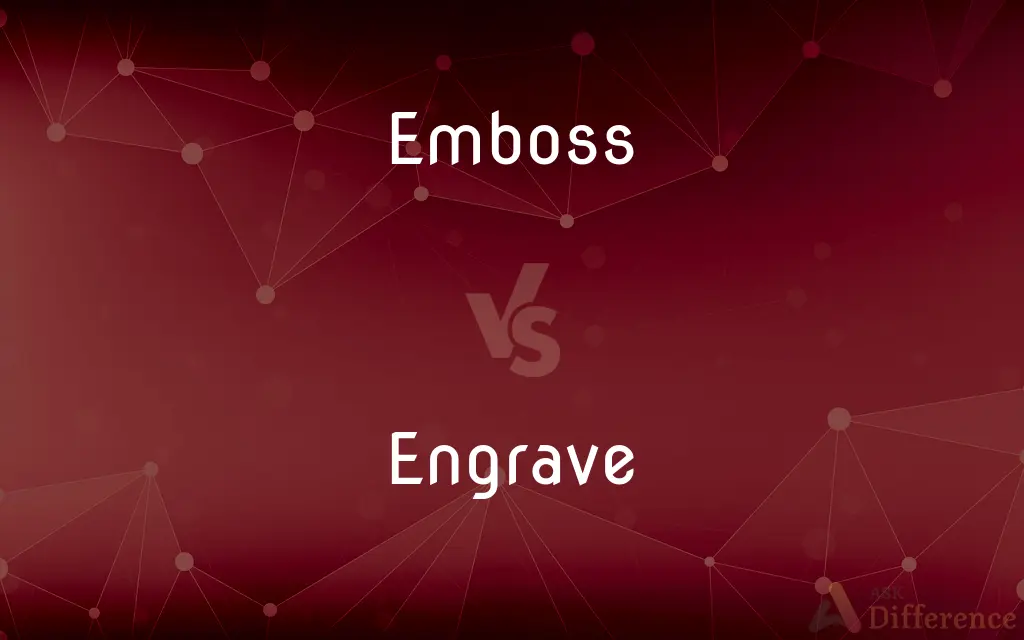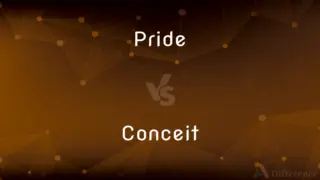Emboss vs. Engrave — What's the Difference?
By Tayyaba Rehman & Maham Liaqat — Updated on April 22, 2024
Embossing creates a raised design on a surface by pressing a template into it, enhancing texture, while engraving cuts or carves designs into a surface, creating a permanent incised effect.

Difference Between Emboss and Engrave
Table of Contents
ADVERTISEMENT
Key Differences
Embossing involves pressing material, typically paper, leather, or metal, between molds known as dies to create a raised, three-dimensional effect. This technique is popular in crafting, such as for greeting cards, book covers, and leather goods. Engraving, on the other hand, involves cutting or carving lines into a surface, often metal, glass, or wood, to create a design that is recessed below the surface level.
The tools and processes used in embossing and engraving differ significantly. Embossing uses dies and a press to create a relief effect without removing material from the base object. Engraving requires tools like burins or lasers to physically remove parts of the material to create a design, which can be filled with ink or left unadorned for visual contrast.
Embossing can be felt as well as seen, as it creates a textured, tactile surface. It's often used to add sophistication and depth to paper products. Engraving, however, is valued for its precision and permanence, making it ideal for detailed artwork, personalized gifts, and commemorative plaques where durability is essential.
In terms of aesthetics, embossing lends a subtle elegance and is frequently used to enhance logos or branding elements without overwhelming the overall design. Engraving offers a more pronounced, distinctive appearance, making it suitable for intricate designs and ensuring that details are permanent and resistant to wear over time.
Both embossing and engraving are used to add a distinctive touch to objects, but the choice between the two techniques depends on the desired outcome and material. Embossing is preferred for adding a touch of luxury with minimal alteration to the material itself, while engraving is chosen for its durability and the depth it can provide to detailed artwork.
ADVERTISEMENT
Comparison Chart
Technique
Creates a raised design by pressing.
Cuts or carves designs into the surface.
Texture
Adds a tactile, three-dimensional effect.
Creates a recessed, incised effect.
Tools
Dies and press.
Burins, lasers, or other cutting tools.
Common Uses
Greeting cards, book covers, leather.
Metal plaques, glass, personalized gifts.
Visual Effect
Subtle, sophisticated.
Distinctive, durable.
Compare with Definitions
Emboss
A technique used in paper craft and leather working.
Embossing tools are essential for anyone interested in advanced paper crafts.
Engrave
To incise a pattern or lettering onto materials like metal or stone.
The award plaque was engraved with the recipient’s name.
Emboss
A method used to add texture and depth to materials.
Embossing the company logo on the folder gave it an elegant touch.
Engrave
To use tools to etch or carve designs.
Artists who engrave often need steady hands and a keen eye for detail.
Emboss
To create a raised pattern by pressing against a mold.
The leather journal was embossed with a unique floral pattern.
Engrave
To carve or cut a design into a hard surface.
He engraved their wedding date into the back of the watch.
Emboss
Enhancing visual and tactile appeal through relief designs.
They chose to emboss the napkins with a delicate border for the event.
Engrave
A method for creating detailed and permanent designs.
Engraving the glass vase added a personalized touch to the gift.
Emboss
To mold or carve a design that stands out in relief.
The invitation featured a beautifully embossed gold monogram.
Engrave
Associated with both artistic and practical applications.
The jeweler engraved the ring with intricate scrollwork.
Emboss
Carve, mould, or stamp a design on (a surface or object) so that it stands out in relief
The silverware is embossed with falcons
An embossed brass dish
Engrave
To carve, cut, or etch into a material
Engraved the champion's name on the trophy.
Emboss
To mold or carve in relief
Emboss a design on a coin.
Engrave
To carve, cut, or etch a design or letters into
Engraved the silver watch with my monogram.
Emboss
To decorate with or as if with a raised design
Emboss leather.
Engrave
To carve, cut, or etch into a block or surface used for printing.
Emboss
To adorn; decorate.
Engrave
To print from a block or plate made by such a process.
Emboss
To cover with many protuberances; stud
“The whole buoy was embossed with barnacles” (Herman Melville).
Engrave
To impress deeply as if by carving or etching
The experience was engraved into his memory.
Emboss
(transitive) To mark or decorate with a raised design or symbol, extrude.
The papers weren't official until the seal had been embossed on them.
Engrave
(transitive) To carve text or symbols into (something), usually for the purposes of identification or art.
He engraved the plaque with his name.
Emboss
(transitive) To raise in relief from a surface, as an ornament, a head on a coin, etc.
Engrave
(transitive) To carve (something) into a material.
He engraved his name.
Emboss
To enhance or polish.
Engrave
(obsolete) To put in a grave, to bury.
Emboss
(obsolete) Of a hunted animal: to take shelter in a wood or forest.
Engrave
To deposit in the grave; to bury.
Emboss
(obsolete) To drive (an animal) to extremity; to exhaust, to make foam at the mouth.
Engrave
To cut in; to make by incision.
Full many wounds in his corrupted fleshHe did engrave.
Emboss
(obsolete) To hide or conceal in a thicket; to imbosk; to enclose, shelter, or shroud in a wood.
Engrave
To cut with a graving instrument in order to form an inscription or pictorial representation; to carve figures; to mark with incisions.
Like . . . . a signet thou engrave the two stones with the names of the children of Israel.
Emboss
(obsolete) To surround; to ensheath; to immerse; to beset.
Engrave
To form or represent by means of incisions upon wood, stone, metal, or the like; as, to engrave an inscription.
Emboss
To raise the surface of into bosses or protuberances; particularly, to ornament with raised work.
Botches and blains must all his flesh emboss.
Engrave
To impress deeply; to infix, as if with a graver.
Engrave principles in men's minds.
Emboss
To make to foam at the mouth, like a hunted animal.
Engrave
Carve, cut, or etch into a material or surface;
Engrave a pen
Engraved the winner's name onto the trophy cup
Emboss
To hide or conceal in a thicket; to imbosk; to inclose, shelter, or shroud in a wood.
In the Arabian woods embossed.
Engrave
Impress or affect deeply;
The event engraved itself into her memory
Emboss
To surround; to ensheath; to immerse; to beset.
A knight her met in mighty arms embossed.
Engrave
Carve, cut, or etch into a block used for printing or print from such a block;
Engrave a letter
Emboss
To seek the bushy forest; to hide in the woods.
Engrave
Carve, cut, or etch a design or letters into;
Engrave the pen with the owner's name
Emboss
Raise in a relief;
Embossed stationary
Common Curiosities
What is the main difference between embossing and engraving?
Embossing creates a raised design by pressing material into a mold, while engraving involves cutting or carving into the material to create a recessed effect.
Can both embossing and engraving be used on metal?
Yes, both techniques can be used on metal, but embossing is typically used on softer metals, while engraving can be applied to almost any type of metal.
Is embossing more durable than engraving?
Engraving is generally more durable because it permanently alters the surface, making it ideal for items that handle wear and tear.
Which technique is better for paper products?
Embossing is more commonly used for paper products as it adds texture without compromising the integrity of the paper.
What are the common mistakes to avoid in engraving?
Common mistakes include incorrect alignment, improper depth settings, and choosing a design too detailed for the material’s surface.
How do I choose between embossing and engraving for my project?
Consider the material, the desired visual and tactile effects, and the durability required for the item to determine the best technique.
What types of materials are unsuitable for embossing and engraving?
Very brittle materials may not handle embossing well, and extremely hard materials like certain ceramics can be difficult to engrave without specialized equipment.
Can embossing and engraving be combined in a single project?
Yes, combining embossing and engraving can add complexity and depth to a project, enhancing both visual appeal and texture.
What are the limitations of embossing?
Embossing can be limited by the material thickness and the complexity of the design, as overly detailed designs may not show up well when raised.
Are embossed and engraved items more expensive?
Both processes involve specialized tools and skills, often making embossed or engraved items more expensive than standard printed ones.
How long do embossing and engraving processes take?
The time varies based on the complexity of the design and the quantity of items being processed, but engraving typically takes longer due to the detail involved.
Is special training required to emboss or engrave?
Both techniques require specific skills and training, especially engraving, which demands precision and an understanding of the tools and materials.
How can I ensure high-quality results in both embossing and engraving?
Use high-quality materials, ensure proper setup and alignment of tools, and work with skilled artisans or reputable companies specializing in these techniques.
Are there environmental concerns associated with embossing or engraving?
Both processes can have environmental impacts, particularly if toxic inks or finishes are used or if substantial waste is produced during the material removal in engraving.
Can engraving be removed or undone?
Engraving is permanent and cannot be undone; however, it can sometimes be modified or covered depending on the material and depth of the original engraving.
Share Your Discovery

Previous Comparison
Pride vs. Conceit
Next Comparison
Nett vs. NetAuthor Spotlight
Written by
Tayyaba RehmanTayyaba Rehman is a distinguished writer, currently serving as a primary contributor to askdifference.com. As a researcher in semantics and etymology, Tayyaba's passion for the complexity of languages and their distinctions has found a perfect home on the platform. Tayyaba delves into the intricacies of language, distinguishing between commonly confused words and phrases, thereby providing clarity for readers worldwide.
Co-written by
Maham Liaqat













































